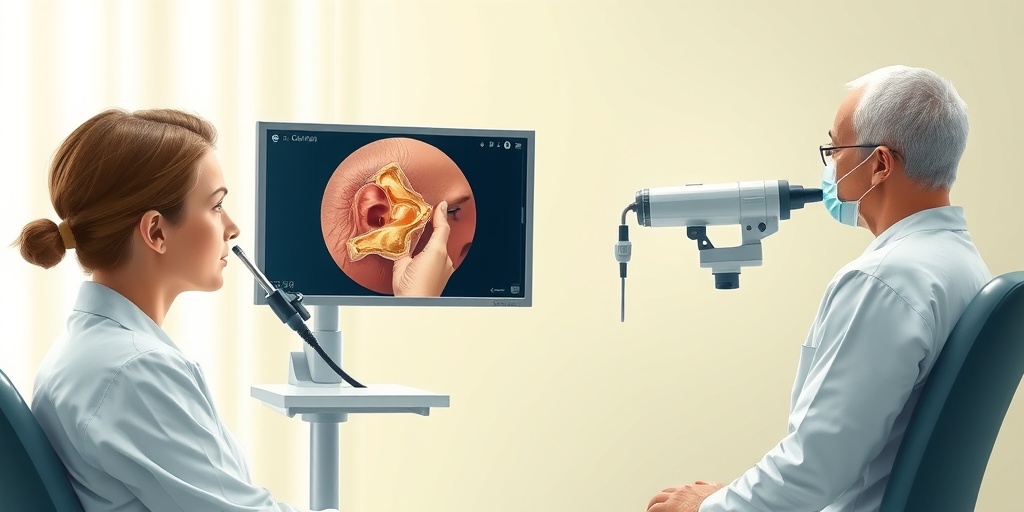What Is Nasal Septal Perforation?
Nasal septal perforation is a medical condition characterized by a hole or tear in the nasal septum, which is the cartilage and bone structure that divides the two nostrils. This condition can arise from various causes, including trauma, chronic nasal inflammation, or the prolonged use of certain medications, such as nasal sprays. Understanding nasal septal perforation is crucial for effective treatment and management.
Causes of Nasal Septal Perforation
The causes of nasal septal perforation can be diverse. Some of the most common include:
- Trauma: Injury to the nose, whether from accidents or surgical procedures, can lead to perforation.
- Chronic Inflammation: Conditions like chronic rhinitis or sinusitis can weaken the septum over time.
- Substance Abuse: The use of cocaine or other drugs can damage the nasal tissues.
- Medical Treatments: Certain medical treatments, such as radiation therapy for nasal cancers, can also result in perforation.
Recognizing the underlying cause is essential for determining the appropriate nasal septal perforation repair method.
Nasal Septal Perforation Symptoms
Identifying the symptoms of nasal septal perforation is vital for early diagnosis and treatment. Symptoms can vary in severity and may include:
Common Symptoms
- Nasal Congestion: A feeling of blockage in one or both nostrils, making it difficult to breathe.
- Nasal Bleeding: Frequent nosebleeds can occur due to the fragile nature of the perforated septum.
- Whistling Sound: A whistling noise when breathing, particularly noticeable during inhalation.
- Crusting and Discharge: Dryness in the nasal passages can lead to crusting and discharge, which may be foul-smelling.
- Facial Pain: Some individuals may experience discomfort or pain in the face, particularly around the nose.
When to Seek Medical Attention
If you experience any of these symptoms, especially if they persist or worsen, it is important to consult a healthcare professional. A nasal septal perforation repair specialist can provide a thorough evaluation and recommend appropriate treatment options.
In some cases, home treatments may alleviate symptoms temporarily, such as using saline nasal sprays to keep the nasal passages moist. However, these are not substitutes for professional medical advice and treatment.
Conclusion
Nasal septal perforation can significantly impact your quality of life, but understanding the condition and its symptoms is the first step toward effective management. If you’re experiencing symptoms, don’t hesitate to reach out to a healthcare provider or a nasal septal perforation repair specialist near you. For more information and resources, consider visiting Yesil Health AI, where you can find evidence-based health answers tailored to your needs.
Taking proactive steps can lead to better outcomes and improved nasal health. Remember, early intervention is key! 🌟

Causes of Nasal Septal Perforation
Nasal septal perforation is a condition characterized by a hole in the nasal septum, the cartilage and bone structure that separates the two nostrils. Understanding the causes of nasal septal perforation is crucial for effective treatment and prevention. Here are some of the most common causes:
1. Chronic Nasal Inflammation
Chronic conditions such as rhinitis or sinusitis can lead to persistent inflammation of the nasal tissues. This inflammation can weaken the septum over time, resulting in perforation. Allergies and irritants, such as smoke or strong odors, can exacerbate these conditions.
2. Trauma
Physical injury to the nose, whether from accidents, sports, or surgical procedures, can cause damage to the septum. Even minor trauma can lead to a perforation if the cartilage is compromised. It’s essential to seek medical attention after any significant nasal injury.
3. Drug Use
Intranasal drug use, particularly with substances like cocaine, can severely damage the nasal tissues. The vasoconstrictive properties of these drugs can lead to reduced blood flow, resulting in tissue death and perforation. If you or someone you know is struggling with substance abuse, seeking help is vital.
4. Infections
Certain infections, such as tuberculosis or fungal infections, can also lead to nasal septal perforation. These infections can erode the septum, causing holes to form. Early diagnosis and treatment of these infections are crucial to prevent complications.
5. Autoimmune Disorders
Conditions like Wegener’s granulomatosis or lupus can affect the nasal tissues, leading to perforation. These disorders cause the immune system to attack healthy tissues, which can include the nasal septum. Regular monitoring and management of autoimmune conditions are essential.
6. Surgical Complications
Surgeries involving the nasal cavity, such as septoplasty or rhinoplasty, can sometimes result in unintended perforations. While these procedures are generally safe, complications can arise, making it important to choose a qualified surgeon and discuss potential risks beforehand.
7. Environmental Factors
Exposure to harsh environmental conditions, such as dry air or pollutants, can contribute to nasal septal perforation. Maintaining a humid environment and avoiding irritants can help protect the nasal tissues.
Diagnosis of Nasal Septal Perforation
Diagnosing nasal septal perforation involves a combination of medical history, physical examination, and imaging studies. Here’s how healthcare professionals typically approach the diagnosis:
1. Medical History
The first step in diagnosing nasal septal perforation is a thorough medical history. Your doctor will ask about:
- Symptoms you are experiencing, such as nasal congestion, bleeding, or whistling sounds when breathing.
- Any history of nasal trauma or surgeries.
- Use of drugs, particularly intranasal substances.
- Chronic conditions or autoimmune disorders.
2. Physical Examination
A physical examination is crucial for diagnosing nasal septal perforation. During this examination, your doctor will:
- Inspect the nasal passages using a nasal speculum.
- Look for signs of inflammation, bleeding, or abnormal tissue.
- Assess the size and location of the perforation, if present.
3. Imaging Studies
In some cases, imaging studies may be necessary to evaluate the extent of the perforation and any underlying issues. Common imaging techniques include:
- X-rays: Useful for assessing bone structure.
- CT scans: Provide detailed images of the nasal cavity and surrounding structures.
4. Biopsy
If there is suspicion of an underlying infection or malignancy, a biopsy may be performed. This involves taking a small sample of tissue from the nasal septum for laboratory analysis.
Early diagnosis of nasal septal perforation is essential for effective treatment. If you suspect you have this condition, consult a healthcare professional for a comprehensive evaluation. 🩺

Nasal Septal Perforation Repair Options
Nasal septal perforation is a condition where there is a hole in the nasal septum, the cartilage and bone that separates the two nasal passages. This condition can lead to various symptoms, including nasal obstruction, crusting, and even nosebleeds. Fortunately, there are several nasal septal perforation repair options available, depending on the size and location of the perforation, as well as the underlying cause.
1. Surgical Repair Techniques
The most common and effective treatment for nasal septal perforation is surgical repair. Here are some of the primary techniques used:
- Flap Repair: This technique involves using tissue from the surrounding area to cover the perforation. Surgeons may use a local flap, which involves moving tissue from nearby areas, or a distant flap, which involves taking tissue from a different part of the body.
- Graft Repair: In cases where the perforation is larger, surgeons may use grafts made from materials such as cartilage or fascia. These grafts provide structural support and help to close the hole.
- Septal Button: For smaller perforations, a septal button can be inserted. This is a small device that fits into the perforation, helping to alleviate symptoms without the need for extensive surgery.
2. Non-Surgical Options
While surgical options are often the most effective, there are also non-surgical treatments that may help manage symptoms:
- Moisturizing Nasal Sprays: These can help alleviate dryness and crusting in the nasal passages.
- Saline Irrigation: Regular saline rinses can help keep the nasal passages clean and reduce irritation.
- Medications: In some cases, medications may be prescribed to manage symptoms such as inflammation or infection.
It’s essential to consult with a nasal septal perforation repair specialist to determine the best treatment option for your specific situation. They can provide personalized recommendations based on the size and cause of the perforation, as well as your overall health.
Preparing for the Repair Procedure
Preparing for a nasal septal perforation repair procedure is crucial for ensuring a smooth surgery and recovery. Here are some steps to help you get ready:
1. Consultation with Your Specialist
Your journey begins with a thorough consultation with a specialist. During this appointment, you will:
- Discuss your symptoms and medical history.
- Undergo a physical examination, including imaging tests if necessary.
- Review the different repair options and decide on the best approach for you.
2. Preoperative Instructions
Once you have decided to proceed with surgery, your doctor will provide specific preoperative instructions. These may include:
- Avoiding Certain Medications: You may need to stop taking blood thinners or anti-inflammatory medications to reduce the risk of bleeding.
- Fasting: You will likely be instructed to fast for a certain period before the surgery, especially if you are undergoing general anesthesia.
- Arranging Transportation: Since you may be groggy after the procedure, it’s essential to have someone drive you home.
3. Preparing Your Home for Recovery
Creating a comfortable recovery environment can significantly impact your healing process. Consider the following:
- Stock Up on Supplies: Have plenty of saline sprays, moisturizers, and any prescribed medications on hand.
- Plan for Rest: Ensure you have a quiet space to rest and recover, free from distractions.
- Limit Physical Activity: Prepare to take time off work and avoid strenuous activities during your recovery period.
By taking these steps, you can help ensure that your nasal septal perforation repair procedure goes smoothly and that you have a successful recovery. Remember, your health and comfort are the top priorities, so don’t hesitate to reach out to your healthcare provider with any questions or concerns! 😊

Recovery After Nasal Septal Repair
Undergoing a nasal septal perforation repair can be a significant step towards improving your nasal health and overall quality of life. However, the recovery process is just as crucial as the surgery itself. Understanding what to expect during recovery can help you navigate this period more comfortably.
Initial Recovery Phase
Immediately after the surgery, you will likely spend some time in a recovery room where medical staff will monitor your vital signs. Once you are stable, you may be discharged the same day or required to stay overnight, depending on the complexity of your procedure.
- Rest is Essential: It’s important to take it easy for the first few days. Avoid strenuous activities, heavy lifting, or any actions that could strain your nasal passages.
- Manage Discomfort: You may experience some pain, swelling, or discomfort. Your doctor will likely prescribe pain medication to help manage these symptoms.
- Follow-Up Appointments: Schedule follow-up visits with your surgeon to monitor your healing progress and address any concerns.
Post-Operative Care Tips
To ensure a smooth recovery after your nasal septal perforation repair, consider the following care tips:
- Keep Your Head Elevated: Sleeping with your head elevated can help reduce swelling and promote healing.
- Avoid Nose Blowing: Refrain from blowing your nose for at least a few weeks post-surgery to prevent complications.
- Stay Hydrated: Drinking plenty of fluids can help keep your nasal passages moist and aid in recovery.
- Use Humidifiers: A humidifier can help maintain moisture in the air, which is beneficial for your nasal passages.
Signs of Complications
While most recoveries are straightforward, it’s essential to be aware of potential complications. Contact your healthcare provider if you experience:
- Increased pain or swelling
- Fever or chills
- Excessive bleeding or discharge from the nose
- Difficulty breathing
Potential Complications and Risks
As with any surgical procedure, nasal septal perforation repair comes with its own set of risks and potential complications. Understanding these can help you make informed decisions and prepare for your surgery.
Common Risks Associated with Surgery
While complications are rare, they can occur. Here are some common risks associated with nasal septal perforation repair:
- Infection: Any surgical procedure carries a risk of infection. Proper post-operative care can help minimize this risk.
- Scarring: Some patients may experience scarring inside the nose, which could affect nasal function.
- Persistent Symptoms: In some cases, patients may continue to experience symptoms such as nasal obstruction or bleeding even after surgery.
Specific Complications to Watch For
In addition to general risks, there are specific complications that can arise from nasal septal perforation repair:
- Septal Hematoma: This occurs when blood collects between the cartilage and the mucous membrane, potentially leading to further complications if not treated.
- Septal Deviation: In some cases, the septum may not heal correctly, leading to a deviation that could require additional surgery.
- Loss of Sense of Smell: Although rare, some patients report changes in their sense of smell following surgery.
Consulting a Specialist
If you have concerns about the risks associated with nasal septal perforation repair, it’s advisable to consult with a specialist. A qualified nasal septal perforation repair specialist can provide personalized insights based on your medical history and specific condition.
In conclusion, while the recovery process and potential complications may seem daunting, being informed and prepared can significantly enhance your experience. Always follow your surgeon’s advice and reach out with any questions or concerns during your recovery journey. 🌟

Frequently Asked Questions about Nasal Septal Perforation Repair
What is Nasal Septal Perforation Repair?
Nasal Septal Perforation Repair is a surgical procedure aimed at closing a hole or perforation in the nasal septum, which is the cartilage and bone structure that separates the two nostrils. This condition can lead to various symptoms, including nasal obstruction, crusting, and frequent nosebleeds.
What are the common symptoms of a nasal septal perforation?
- Nasal obstruction
- Crusting inside the nose
- Frequent nosebleeds
- Whistling sound when breathing
- Facial pain or discomfort
How is the repair procedure performed?
The procedure typically involves the use of local or general anesthesia. The surgeon will access the perforation through the nostrils and may use various techniques, such as grafting tissue, to close the hole. The specific method will depend on the size and location of the perforation.
What is the recovery process like?
After nasal septal perforation repair, patients may experience some swelling and discomfort. It is essential to follow post-operative care instructions, which may include avoiding strenuous activities and keeping the nasal passages moist. Most patients can return to normal activities within a few weeks.
How much does nasal septal perforation repair cost?
The cost of nasal septal perforation repair can vary widely based on factors such as the surgeon’s experience, the complexity of the procedure, and geographic location. On average, patients can expect to pay anywhere from $3,000 to $10,000, depending on these factors.
Where can I find a nasal septal perforation repair specialist near me?
To find a nasal septal perforation repair specialist, consider searching online for ENT (Ear, Nose, and Throat) specialists in your area. You can also ask for referrals from your primary care physician or check local hospital directories.
Are there non-surgical treatments for nasal septal perforation?
While surgery is often the most effective treatment, some non-surgical options may help manage symptoms. These can include:
- Saline nasal sprays to keep the nasal passages moist
- Antibiotics for infections
- Using a humidifier to improve air quality
What is the CPT code for nasal septal perforation repair?
The CPT code for nasal septal perforation repair can vary based on the specific procedure performed. It is best to consult with your healthcare provider or insurance company for the exact code related to your treatment.
Can I treat nasal septum perforation at home?
While some home remedies may alleviate symptoms, such as using saline sprays or humidifiers, it is crucial to consult a healthcare professional for a proper diagnosis and treatment plan. Home treatments are not a substitute for professional medical care.
Is there a risk of complications after the surgery?
As with any surgical procedure, there are potential risks involved, including infection, bleeding, and recurrence of the perforation. Discussing these risks with your surgeon beforehand can help you make an informed decision.
How long does the surgery take?
The duration of nasal septal perforation repair surgery typically ranges from 1 to 3 hours, depending on the complexity of the case and the techniques used by the surgeon.




